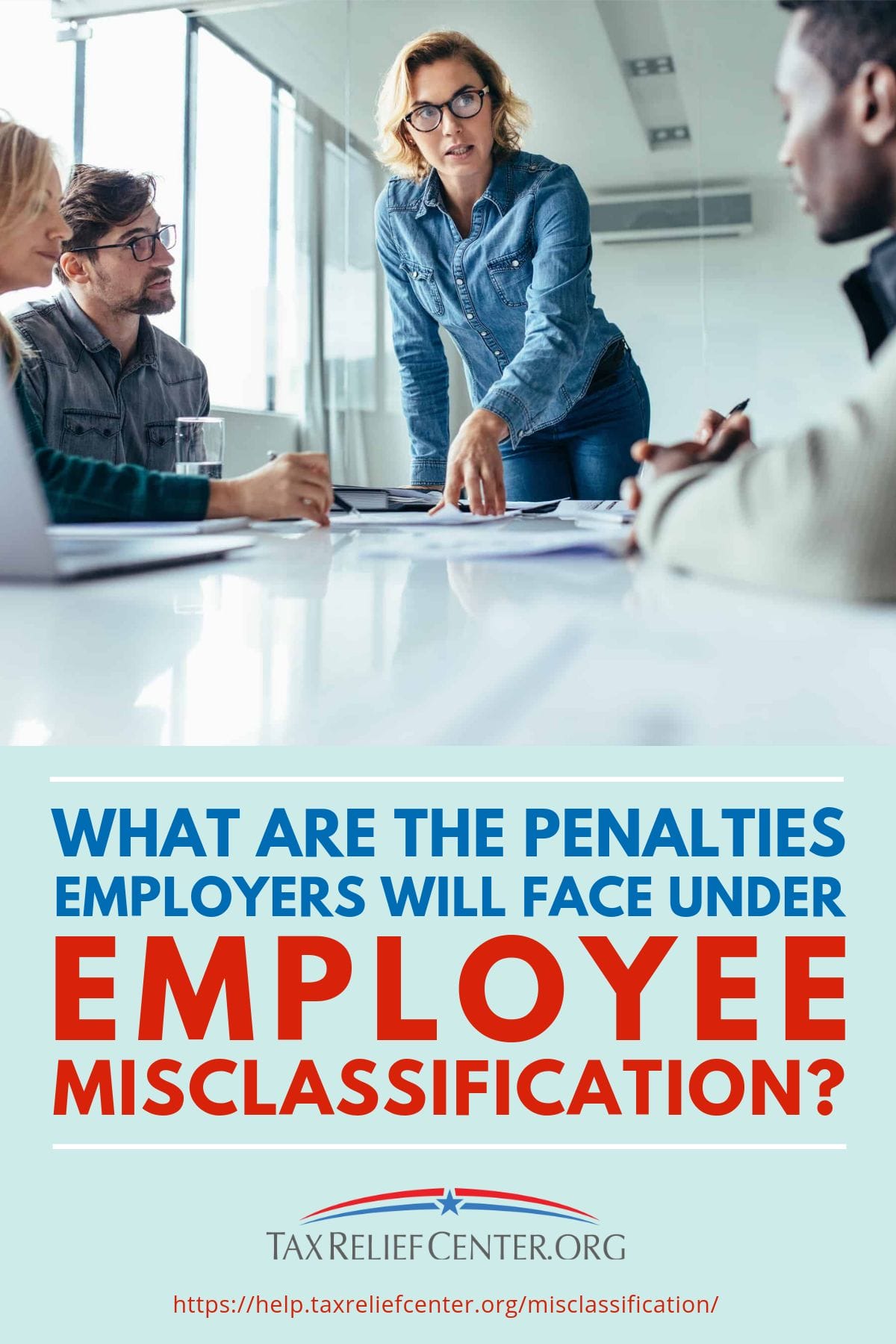Employee misclassification leads not only to penalties, but also to injustice. Arm yourself with the facts to prevent the inevitable headache.
RELATED: 11 Tax Sins Not To Commit To Avoid Tax Fraud Charges
In this article:
- What Is Employee Misclassification?
- Why Does the IRS Care About Employee Misclassification?
- What Are the Employee Misclassification Penalties?
- How Do I Know If I Am an Employee Under State Law?
- How to Correct Employee Misclassification
- What Can Happen in an Employee Misclassification Lawsuit?
What Is Employee Misclassification?
An employee misclassification happens when an employer labels a worker as an independent contractor when the worker should be tagged as an employee.
According to local state figures, around 10% to 20% of employers misclassify employees as independent contractors. In fact, between 2010 to 2015, penalized taxpayers due to misclassification rose from 7.2 million to 10 million, which is an alarming 40% growth.
Usually, this incorrect reporting arises from ignorance. However, some employers misclassify employees maliciously.
Whatever the reason, the IRS will penalize the employer. Employee misclassification affects both the workers and the state negatively, which pushes the IRS to implement rules to curb this misrepresentation.
The IRS can impose not just the common penalties and fees but may also add a tax levy to properties.
Why Does the IRS Care About Employee Misclassification?
The IRS is interested in curbing the growing misrepresentation due to two main reasons: tax revenues and streamlined processes.
A taxpayer receives the tax deductions and benefits afforded to an employee only if he or she is labeled properly. Also, the IRS will want to streamline the tax collection process, which employers do as business owners withhold and send most tax withholding for employees.
Misclassified employees suffer not only from paying more taxes, but also from less benefits like insurance. This lack of insurance can increase out-of-pocket costs for employees.
For example, hazardous and labor-intensive careers, like those in construction and mining, can merit hazard pay and insurance that may reach 50% of total salary if the business owner classifies the worker as an employee.
Other negative effects for misclassified employees are irregular work hours, as well as incurred costs like shouldering entire social security contributions. Also, federal unemployment taxes and Medicare payments have employer contributions, and misclassified employees have to cover the rest if the employer has tagged them as independent contractors.
Taxes from workers take up a valuable revenue source for the IRS, and tax collection requires specialized expertise. As employers take responsibility for filing tax reports of employees together with other crucial kinds of taxes, employee misclassification lowers not only tax revenue but also increases the usage of human resources — which constitutes added cost for the IRS.
What Are the Employee Misclassification Penalties?

If the IRS thinks that the employer-taxpayer mistakenly misclassified an employee, the IRS can levy:
- Unfiled W-2 fee, which is $50
- 100% of the matching FICA payments, FICA being Social Security and Medicare
- Additional 40% of the employee’s part in FICA
- Another 1.5% of the misclassified salary, and interest on the whole worker’s wages
If during an investigation by the Department of Labor suspicion regarding malicious misclassification arises, the IRS will enforce additional penalties. These penalties are:
- An additional 20% of all wages paid by the employer to the misclassified employee.
- FICA contributions now wholly paid by the employer, 100% for both employer and employee share of Medicare and Social Security
- Possible fine of $1,000 for every misclassified employee
- Imprisonment of up to 1 year
Other than penalties and fees by the IRS, the misclassified employees can also ask the courts to grant them:
- Retirement benefits, specifically 401(k) employer contributions
- Paid Time Off, like vacation leaves, as well as break time if still employed
- Investment benefits, like stock options in case the employer offers these options to employees
- Health insurance
- The unpaid overtime the misclassified employer did not pay
Both employer and employee taxpayers should meet with a tax relief specialist regarding an employee misclassification issue. Penalties and benefits are not the only reason why taxpayers should avoid incorrect labeling; loss of trust in their company and brand can dampen profitability, which in turn can make tax payment harder than before.
RELATED: What Happens If You Don’t File Your Taxes For 5 Years Or More?
How Do I Know If I Am an Employee Under State Law?
Due to the growing gig economy where employers are beginning to prefer independent contractors to regular employees, the number of misclassified employees is on the rise.
Sometimes, employers do not know how to classify a worker, and knowing the rules on the employer-employee relationship can help taxpayers label themselves accurately.
Both the IRS and State Department of Labor may have different standards. However, taxpayers may want to ensure that they measure against both the federal and local employee tests, as the IRS and the state may refer to the other agency’s findings.
If a worker answers yes to most of the questions below, he or she is most likely an employee:
- Does the employer supervises or manages the worker?
- Can the employer, in his or her discretion, discharge the worker?
- Is the worker paid by time, not by the number of projects?
- Is the role of the worker critical or necessary to the business?
- Does either the employer or employee believe that they are employees due to any document or action?
- Is the employer responsible for supplying needed materials to perform the task?
Cases regarding labor can have nuances and complexities not known by most of the public. Contacting the IRS to ask questions, whether as an employee or employer, can help resolve any confusion or questions about employee classification.
How to Correct Employee Misclassification
First, workers should ask their employers to clarify their position. Sometimes, a simple reminder or inquiry can remind employers to justly classify workers.
If the employee does not agree with the classification, he or she can fill out Form SS-8 Determination of Worker Status. The IRS does not apply any fee for this form.
Please bear in mind that this form does not guarantee anonymity, which can affect your work relationship.
Upon determination of your status as an employee, a worker can go to their local Department of Labor to inform them about the situation.
If the employer discharged the worker before resolving the proper classification, the worker may file an Unemployment Insurance Claim to the authorities. On the other hand, a worker can file a Workers’ Comp Claim to their state Department of Labor branch if the employer refuses to shell out the proper compensation and benefits.
What Can Happen in an Employee Misclassification Lawsuit?

Technically, both parties have two proceedings to check. First refers to the legal status, specifically the worker’s classification which falls under the jurisdiction of the Department of Labor.
Lastly, inaccurate tax reporting falls under the IRS. This reporting triggers an audit on the part of the employer, and results of the IRS findings can also function as evidence in the courts.
Employee misclassification costs, not only crucial tax revenue, but also causes difficult economic situations for workers. Proper reporting lowers the risk of IRS penalties, as well as makes the whole tax collection process convenient for all.
What are your thoughts about employee misclassification? Have you encountered it before? Let us discuss in the comments section below.
If you owe back taxes, visit taxreliefcenter.org for more information on tax relief options.
Up Next:
- Filing Tax Extension | A Complete Guide [INFOGRAPHIC]
- 6 Tips to Avoid Wage Garnishment
- Tax Debt Forgiveness Frequently Asked Questions


